Dhanraj M, Hemalatha Ranganathan, Ashish R. Jain and Acu. Varma
Department of Prosthodontics, Saveetha Dental College and Hospitals, Saveetha University, Chennai, India.
Corresponding Author E-mail: dr.ashishjain_r@yahoo.com
DOI : https://dx.doi.org/10.13005/bpj/1187
Abstract
The role of abutment tooth preparations and their modifications influencing retention in complete veneer restorations needs to be investigated further in detail. To estimate and compare the effectiveness of conventional and surface modified tooth preparation designs in providing retention in complete veneer restorations. An electronic search was conducted for scholarly articles discussing about retention in complete veneer restorations written in English or translated into English listed with pubmed ,Cochrane library, Science Direct, Wiley online library, Google scholar data bases, The Newyork Academy of Medicine Grey literature Report and Ingenta Connect till october 31st 2016 with suitable keywords. The database search yielded 57 articles out of which 42 articles were discarded after reading the abstract. Full texts were obtained for the remaining 15 articles. 9 articles were selected based on the inclusion criteria and were subjected to data extraction. The effect size was difference between the means of forces dislodging the crowns in the conventional and surface modified abutments. The meta analysis exhibited overall effect size z = 27.99 (p < 0.00001) at 95 % CI indicating a very high statistically significant difference between the conventional and surface modified tooth preparation for complete veneer crowns in the amount of retention provided. Based on the evidence provided by the literature ,Surface modified abutments for complete veneer restorations exhibited a greater the amount of retention than the conventionally prepared abutments. Hence abutment surface modifications during tooth preparation can be incorporated in complete veneer restorations in clinical situations demanding additional retention to ensure better clinical success.
Keywords
Abutments surface modifications; complete veneer crowns; retention; tooth preparation
Download this article as:| Copy the following to cite this article: Dhanraj M, Ranganathan H, Jain A. R, Varma A. Effect of Tooth Surface Modifications Influencing Retention in Complete Veneer Restorations-A Systematic Review and Meta Analysis. Biomed Pharmacol J 2017;10(2). |
| Copy the following to cite this URL: Dhanraj M, Ranganathan H, Jain A. R, Varma A. Effect of Tooth Surface Modifications Influencing Retention in Complete Veneer Restorations-A Systematic Review and Meta Analysis. Biomed Pharmacol J 2017;10(2). Available from: http://biomedpharmajournal.org/?p=14747 |
Introduction
In the management of partially edentulous situations the patient preference hinges towards the fixed prosthesis in many situations. Amongst the fixed restorations, the two therapeutic options available to accomplish tooth replacement include tooth supported and implant retained fixed partial dentures. Implant retained prosthesis is the primary modality of management in replacement of lost natural teeth. However, when implant restorations are not feasible the only fixed restorative option left will be tooth supported fixed partial dentures. Complete veneer fixed restorations are the only choice is restoring endodontically treated teeth also.1
Complete veneer restorations involve significant amount of tooth surface reduction to support the prosthesis. The amount of tooth reduction performed is dependent predominantly on the choice of restorative material used. Metallic restorations are the most conservative involving the tooth reduction of 1mm circumferentially with chamfer margin. Metal ceramic restorative materials involve a moderate amount of tooth reduction of 1.5 mm circumferentially with shoulder margins.2 All ceramic restorative materials involve the maximum amount of tooth reduction of 2 mm with shoulder or heavy chamfer margin and this is considered to be the most aggressive tooth preparation.
The common factors influencing retention include the taper and geometry of the tooth preparation, surface area of tooth involved, magnitude of dislodging forces, occlusal stresses and luting agents. The taper of the tooth preparation is a very important factor influencing retention.2 The established guidelines for the amount of taper for clinically optimal retention ranges from 6 to 20 degrees. There are numerous studies demonstrating a progressive decrease in the amount of retention with increased taper angle.2 There are many factors which alters the occluso cervical height of the abutment teeth. Regressive alterations of the tooth surfaces viz.attrition, abrasion and erosion of teeth results in marked noncarious loss of tooth structure which leads to the increased prevalence of abutments with short clinical crowns in the human dentition.In addition to this,extensive caries, fractures involving the enamel and dentin ,occlusal disharmony ,abfraction and developmental anomalies involving the enamel and dentin also severely compromises the morphological structure and height of the existing clinical crowns . When such teeth are subjected to tooth preparation , establishment of retention and resistance forms will be severely challenging to the clinicians. The dislodgment of crowns due to lack of retention and resistance can compromise function or esthetics. Walton et al have reported short clinical abutments exhibited dislodgement of crowns in almost two-thirds of the clinical situations.
The mechanical sucess of tooth preparations have been attributed largely to both the retention and resistance forms.3 Retention form denotes all the features of a tooth preparation which enhances the stability of the restorations and resistance to dislodgment along the path of insertion. Resistance form denotes the features in tooth preparation that improves the stability of the prostheses or restoration and resistance to displacement along an axis apart the path of insertion. Resistance to lateral displacing forces is the most important determinant for retention of cemented restorations and crowns.4
Several authors have proposed a minimal axial taper ranging from 2 to 6 degrees for tooth preparation ,however 6 to 12 degree total occlusal convergence(TOC) offered the maximum retention for crowns. Despite this recommendation for a minimal TOC, in routine clinical procedures the normal TOC acheived by operators ranged from 12 to 27 degrees.5 Dodge et al stated various factors such as accessibility of the preparation site, morphology of the prepared teeth, proximal contacts between the prepared and unprepared teeth, and caliber of the operator played important roles in establishing the optimal TOC in complete veneer preparations. They concluded 16 degrees was the optimal and the most commonly achievable convergence angle in clinical situations. Shillingburg et al also have concluded the TOC is frequently between 10 and 22 degrees in tooth preparations for full veneer crowns.6
The least maximum height required to provide sufficient resistance for complete veneer crowns in the anterior region was 3mm and the taper was in the range between 6 to 20 degrees as reported by Goodacre et al.They proposed 4 mm as the least optimal height for prepared molars ,as molar teeth preparation is done with greater occlusal convergence than the anteriors and because of their wider diameter are subjected to greater occlusal forces.7
To improve the resistance form in tooth preparations with excessive axial taper or in short clinical crowns, additional auxiliary retention features could be incorporated.Apart from the preparation design ,the retention can be influenced by the luting cements and casting techniques as well. Woolsey and Matich concluded that the proximal grooves demonstrated complete resistance to dislodging forces in the faciolingual directions. The grooves and boxes prepared over the axial surfaces when placed in prepared axial surfaces, enhanced the resistance form to a marked extent. An another method of improving the resistance form of a tooth preparation with an excessive taper was to prepare the apical portion with a reduced TOC.4
Reisbick and Shillingburg were the initial investigators studying the essential features of a crown preparation to improve the retention and resistance forms. They reported that the axial grooves and boxes increased the resistance form of the tooth preparation. They concluded that the placement of boxes was more effective in providing resistance than the grooves. With regards to the placement of grooves, the grooves placed in an interproximal location offered more resistance over grooves placed in a buccolingual location when the forces were applied in a buccolingual direction.8
Several studies have shown that TOC is not consistent among the operators in invivo conditions. Location of the tooth to be prepared is a crucial factor in accompolishing adequate retention and resistance form . The maxillary and mandibular posterior teeth frequently associated with the most inadequate total occlusal convergence during tooth preparation.However the incorporation of additional retentive features in overtapered preparations were rarely observed in clinical situations. Occlusal surface preparation can also affect the resistance form in complete crown preparation. The placement of inclined planes and functional cuspal bevel on the occlusal surface of a crown preparation can increase the resistance form than the flat occlusal surface preparation. The placement of occlusal isthmus will also improve the resistance form in tooth preparations.9 Despite the various existing opinions , the overall effectiveness and performance of the various auxiliary retention and resistance features remains uncertain in the literature. Hence this systematic review and meta analysis was performed to obtain more clarity over the effect of mechanical methods of tooth surface modifications influencing retention in complete veneer crowns.
AIM
To estimate and compare the effectiveness with the amount of retention provided by conventional and surface modified tooth preparation designs in complete veneer restorations.
Objectives
To evaluate the effect of abutment height influencing amount of retention in complete veneer restorations.
To evaluate the effect of surface modifications influencing amount of retention in complete veneer restorations
To evaluate the effect of surface roughness of abutments influencing amount of retention in complete veneer restorations
Pico Analysis
Population
Teeth subjected to complete veneer tooth preparation.
Intervention
Conventional tooth preparation.
Comparison
Tooth preparation technique with surface modification.
Outcome
Retention measured as the tensile bond strength between the prepared abutment teeth and the complete veneer restoration.
Resistance
Variables of Interest
Influence of the following factors on marginal discrepancy
Resistance
Type of finish line
Amount of tooth preparation
Height of tooth preparation
Axial taper
Film thickness of luting agents
Sand blasting
Modification of intaglio surface of the crowns
Marginal leakage
Bio compatibility.
surface area
magnitude of dislodging forces
direction of dislodging forces.
type of luting agents.
Materials and Methods
Sources used
An electronic search was conducted for articles written in English or translated into English listed with pubmed ,Cochranelibrary, ScienceDirect, Wiley online library,Google scholar data bases,TheNewyork Academy of Medicine Grey literature Report,Ingenta Connect till October 31st 2015 reporting retention of complete veneer restorations
Pico Analysis
Search Methodology
The search methodology applied was a combination of MESH terms and suitable keywords.The terms complete veneer crowns and tooth surface modifications and other relavent keywords were not enlisted in the MeSH database and hence discrete keyword search was initiated based on PICO cluster.
Population
Crowns, Veneer ,Complete veneer, Full crown, Full coverage restoration, Complete coverage restoration, Total coverage restoration, Full metal crown, All metal crown, All metal restoration,Metal ceramic crown, Metal ceramic restoration, Porcelain fused to metal crown, All ceramic crown.tooth preparation , complete veneer retainers
Intervention
Sand blasting, Roughness in tooth preparation, Surface modification in tooth preparation, Slots, Grooves, Pins, Pin holes, Ledges, Pin ledges, Keys, Keyways, Linear grooves, Buccal grooves, Proximal grooves, Palatal grooves, Axio proximal grooves, Incisal grooves, Isthumus, Occlusal isthumus, Proximal box, Offset, acid etching
Comparision
Abutments, Abutment height, Adequate abutment height, Finished surfaces, Tooth preparation for complete crowns, Tooth preparation for full veneers, Tooth preparation for porcelain fused to metal crowns, Tooth preparation for porcelain fused to metal veneers, Tooth preparation for all ceramic crowns, Tooth preparation for all ceramic veneers, Natural teeth abutment angulation
Outcome
Resistance, Retention, Tensile bond strength, Shear bond strength, Pull out strength, Pull out test, Tensile testing, Shear testing, Frictional fit, Frictional resistance, Retention failure, Retention loss, Retention fracture, Retention grooves, Retentive ability.
Selection of Studies
The review process consisted of two phases.During the initial phase titles and abstract of the search were thoroughly screened for relevance and the full text of relevant abstracts were obtained. The articles which were obtained after first step of review process using the following inclusion and exclusion criteria were screened in second phase and relevant and suitable articles were identified and isolated for further processing and data extraction
Inclusion Criteria
The articles discussing the following parameters were included for the systematic review.
Randomized control trials reporting retention in complete veneer tooth preparations.
Controlled invitro trial reporting retention in complete veneer tooth preparations.
Experimental research reporting retention in complete veneer tooth preparations.
Experimental research reporting Mesiodistal grooves.
Experimental research reporting Mesiodistal boxes.
Experimental research reporting Buccal-lingual grooves.
Experimental research reporting Occlusalinclinedplanes.
Experimental research reporting Occlusal isthmus.
Experimental research reporting Reduced total occlusal convergence.
Exclusion Criteria
Articles and manuscripts discussing the following parameters were excluded:
Case reports or case series
Tooth prepartion involving endodontically treated teeth with post and core.
Complete veneer restoration for implant supported prosthesis
Tooth and implant supported prosthesis
Tooth preparation in decidious teeth
Tooth preparation in periodontically compromised teeth.
Tooth preparation in teeth underwent radisection or hemisection
Tooth preparation of over denture abutments.
tooth preparation in implant crowns.
tooth preparation for abutments receiving precision attachments.
abutment fractures.
Results
The database search yielded 57 articles out of which 42 articles were discarded after assesing the abstract. Complete texts were obtained for the remaining 15 articles. 9 articles were selected based on the inclusion criteria and 6 articles were excluded. The finally selected 9 articles were subjected to data extraction.The CEBM levels of evidence were affixed for the selected articles and all the relevant information were extracted and processed and studied further in detail and subjected to statistical analysis.
Data Extraction
The data from the finally included studied were tabulated and the following information were extracted
Study designed applied
The teeth subjected to tooth preparation
Axial wall taper
Height of abutment teeth
Surface area of abutment teeth
Modification of abutment teeth
Amount of dislodging forces
Amount of stress
Type of luting agent
Measurement of the outcome
Gadgets used for measurements
Statistical test involved
Flow Chart for Search Stratergy
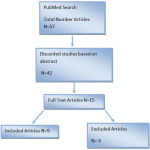 |
Graph 1
|
Results
All the included invitro studies where categorized as 3B as per Oxford Centre for evidence based medicine .Six studies were identified discussing retention based on abutment modification by mechanical methods (Table 1)and two studies were reported variation in retention level based on abutment height(Table 2) and three studies evaluated the amount of retention based on surface roughness (Table 3)induced over the abutment surfaces. The data were extracted from the afore mentioned studies and a meta analysis was done to evaluate the influence of surface modification over conventional methods.
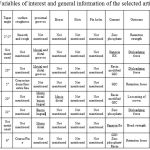 |
Table 1: Variables of interest and general information of the selected articles.
|
 |
Table 2: Extraction of existing data regarding retention.
|
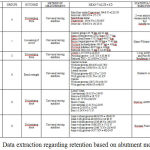 |
Table 3: Data extraction regarding retention based on abutment modification.
|
The effect size was difference between the means of forces dislodging the crowns in the conventional and surface modified abutments Meta analysis showed overall effect size z = 27.99 (p < 0.00001) at 95%CI indicating a very high statistically significant difference between the conventional and surface modified abutments(Fig 1).
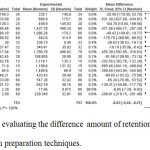 |
Figure 1: Meta analysis evaluating the difference amount of retention offered by conventional and surface modified tooth preparation techniques.
|
Discussion
The results of the meta analysis clearly established surface modifications induced in the abutment preparation significantly altered the amount of retention in the prepared abutments. All the studies included in this review were experimental invitro studies and there might be a slight amount of variation when the results of the study are extrapolated to address similar clinical situations. The other parameters influencing retention include the amount of dislodging forces, the amount of stress transmission in the abutments, periodontal health of abutments, off directional forces transmitted due to over contoured restorations perforated restorations can influence the outcome.
Emara et al10 evaluated the effect of proximal grooves on the retention and resistance of cast resin-bonded retainers for mandibular and maxillary second molar teeth. The grooves significantly increased the debonding forces for maxillary molars . The effect of the grooves over the mandibular second molars was not significant.
 |
Table 4: Data extraction regarding retention based on abutment height.
|
Huang et al11 studied the effects of proximal grooves and abutment height on the retention and resistance forms . Proximal grooves improved the resistance with abutment height of 4 mm, whereas addition of grooves had no significant differences in resistance in abutment heights of 2 and 3 mm. The 2 mm groups exhibited the least performance than the other groups irrespective of the proximal grooves. An abutment height of 3 mm exhibited adequate resistance for single cast crowns when self adhesive modified resin cement was used. Preparation of proximal grooves on abutments shorter than 4 mm height had no significant influence on the resistance.
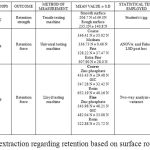 |
Table 5: Data extraction regarding retention based on surface roughness.
|
Li et al12 studied the relationship between the surface roughness of prepared teeth and the internal adaptation and retention of complete veneer crowns following preparation with diamond rotary instruments of various grit sizes. The highest mean surface roughness (SD) (4.8 (0.4) μm) was observed in teeth reduced with the coarsest diamond. The teeth reduced with the finest diamond instruments showed the lowest mean cement thickness (0.5 (1.2) um. The finer tooth surface preparations exhibited less microleakage (P =.03). However, no significant differences in retention were observed (P=.19) across the experimental groups. Teeth prepared with the finer grit instruments had smoother surfaces and crowns with better internal adaptation. The grit size of the diamond instruments did not affect the dislodging forces between the complete veneer crowns and the prepared teeth.
Proussaefs et al 9 studied the effectiveness of various auxiliary preparation features over the retention and resistance form of complete veneer crowns with reduced axial heights and total occlusal convergence. Proximal grooves, boxes, buccolingual grooves, occlusal inclined planes, and occlusal isthmus were less effective at improving the resistance of crown to displacement when the tooth preparation lacked resistance form . The only crown modification that showed increased resistance than the control group was the reduced TOC in the cervical half of the axial wall. Placement of auxiliary retentive features such as grooves and boxes into a compromised tooth preparation with 2.5 mm occlusocervical dimension and 20-degree TOC were not effective when these retentive features possessed the same 20-degree TOC as the prepared axial walls.
Roudsari et al4 evaluated the effect of various auxiliary features on the resistance form of crowns with reduced height of the axial walls and increased total occlusal convergence. They concluded the crown preparation modifications improved and enhanced the resistance form. Neverthless, the reduction in cervical TOC was more effective than the placement of proximal grooves.
Tuntiprawon 13 investigated the effect of axial surface roughness on the marginal adaptation and retention of silver-palladium cast crowns luted with zinc phosphate, resin and glass ionomer cements.Coarse and fine grit diamond instruments were used to create varying levels surface roughness in premolars. Superior retention for complete cast crowns was observed for tooth preparations done with coarse diamonds and luted with Panavia 21 resin cement. Variations in axial surface roughness of tooth preparations had no effect over the marginal adaptation of the complete coverage cast crowns.
Vinaya et al 14 studied the retention of complete cast metal crowns in teeth with adequate and inadequate crown heights and also evaluated the effects of auxiliary retentive features over retention form in the same. Complete cast metal crowns on teeth with adequate crown height exhibited greater retention than the ones with inadequate crown height. Proximal grooves provided greater amount of retention when compared with proximal boxes There was no statistically significant difference among long conventional and short groove preparation.
Arora et al 15 observed in complete veneer tooth preparation on a clinically compromised teeth with reduced occluso cervical height and increased TOC, the crown preparation modification that offered the greatest resistance form was the reduction of TOC at the apical 1.5 mm of the axial wall. Incorporation of inter proximal grooves with 1 mm of width and depth in the gingival third also significantly improved the retention but less compared to the cervical tooth preparation.
The effectiveness of retentive grooves are also dependent on the occluso cervical height of the crown and the axial taper. When the clinical crown height is critically reduced, further incorporation of interproximal grooves may not improve resistance.16
Wiskott et al10 stated the resistance to lateral displacement is a function of the distribution of complex compressive ,tensile and shear force vectors acting at the luting cement ,restoration and tooth interface. The length of the edentulous span, the type of abutments chosen like, pier abutments or cantilever abutments or tilted abutments, type of luting agents used, their compressive tensile and shear loading, dissolution of luting cements in saliva could be other factors capable of altering the retention and resistance outcome.The mechanical modifications incorporated involve high degree of precision and technique sensitivity and specialized equipment may be needed to incorporate the modifications into the restorations. However advanced CADCAM17 designing will enable the incorporation of these modifications more user friendly and less technique sensitive.
All the studies included in this review were performed in an in vitro environment and evaluation of retention by mechanical methods may not be possible in an in vivo situation. In clinical situation retention can be evaluated by assessment of longevity of the restorations over varying periods of time, hence more longitudinal studies assessing the performance of surface modified abutments needs to be initiated further to ensure better understanding of the phenomenon.18 In clinical situations fracture of the abutments, fracture of restorations or perforation of the restoration can also lead to loss of retention.
These factors should be carefully analysed and interpreted with due consideration.Surface modification through mechanical methods can be extremely challenging in clinical situations, however success can be ensured by following meticulous care in clinical and laboratory procedures.19
The incorporation of specialised impression materials and optical impression have faciliated this process to a greater extent.20 The surface modification increase the surface area and provides mechanical locks providing additional amounts of retention and resistance as well.Hence the mechanical methods can greatly resist the sheer or torsional rotational forces acting in the oral cavity during function ,thus enhancing the clinical longevity and performance of complete venner crowns.
Conclusion
Based on the evidence provided by the literature ,Surface modified abutments exhibited a greater the amount of retention than the conventionally prepared abutments . Hence abutment surface modifications during complete veneer tooth preparation can be incorporated in all clinical situations demanding additional retention to ensure better clinical success.
Reference
- Jeyavalan M. I., Narasimman M., Venkatakrishnan C. J., Philip J. M. Management of long span partially edentulous maxilla with fixed removable denture prosthesis. Contemp Clin Dent. 2012;3(3):314–6.
CrossRef - Kent W. A., Shillingburg H. T., Duncanson M. G. Taper of clinical preparations for cast restorations. Quintessence Int Berl Ger 1985. 1988;19(5):339–45.
- Kishimoto M., Shillingburg H. T., Duncanson M. G. Influence of preparation features on retention and resistance. Part II: Three-quarter crowns. J Prosthet Dent. 1983;49(2):188–92.
CrossRef - Roudsari R. V., Satterthwaite J. D. The influence of auxiliary features on the resistance form of short molars prepared for complete cast crowns. J Prosthet Dent. 2011;106(5):305–9.
CrossRef - Chan D. C. N., Wilson A. H., Barbe P., Cronin R. J., Chung C., Chung K. Effect of preparation convergence on retention and seating discrepancy of complete veneer crowns. J Oral Rehabil. 2004;31(10):1007–13.
CrossRef - Vinnakota D. N. Effect of preparation convergence on retention of multiple unit restorations – An in vitro study. Contemp Clin Dent. 2015;6(3):409–13.
CrossRef - Goodacre C. J., Campagni W. V., Aquilino S. A. Tooth preparations for complete crowns: An art form based on scientific principles. J Prosthet Dent. 85:363–76.
CrossRef - Farshad B., Ehsan G., Mahmoud S., Reza K., Mozhdeh B. Evaluation of resistance form of different preparation features on mandibular molars. Indian J Dent Res. 2013;24(2):216.
CrossRef - Proussaefs P., Campagni W., Bernal G., Goodacre C., Kim J. The effectiveness of auxiliary features on a tooth preparation with inadequate resistance form. J Prosthet Dent. 2004;91(1):33–41.
CrossRef - Emara R. Z., Byrne D., Hussey D. L., Claffey N. Effect of groove placement on the retention/resistance of resin-bonded retainers for maxillary and mandibular second molars. J Prosthet Dent. 2001;85(5):472–8.
CrossRef - Huang Z., Zhang L., Zhu J., Zhao Y., Zhang X. Clinical Marginal and Internal Fit of Crowns Fabricated Using Different CAD/CAM Technologies. J Prosthodont. 2015;24(4):291–5.
CrossRef - Li Y., Wang H., Wang Y., Chen J. Effect of different grit sizes of diamond rotary instruments for tooth preparation on the retention and adaptation of complete coverage restorations. J Prosthet Dent. 2012;107(2):86–93.
CrossRef - Tuntiprawon M. Effect of tooth surface roughness on marginal seating and retention of complete metal crowns. J Prosthet Dent. 1999;81(2):142–7.
CrossRef - Vinaya K., Rakshith H., Prasad D. K., Manoj S., Sunil M., Naresh S. To Evaluate & Compare Retention of Complete Cast Crown in Natural Teeth Using Different Auxiliary Retentive Features with Two Different Crown Heights – An In Vitro Study. Int J Biomed Sci IJBS. 2015;11(2):99–106.
- Arora A., Upadhyaya V., Arora S. J., Sangwan R. Evaluation of the effectiveness of auxiliary features on resistance with decreased occluso-cervical height: An In Vitro study. Indian Journal of Dental Sciences. 2016;8(3):139.
CrossRef - Lu P. C., Wilson P. Effect of Auxiliary Grooves on Molar Crown Preparations Lacking Resistance Form: A Laboratory Study. J Prosthodont. 2008;17(2):85–91.
CrossRef - Lee K. H., Yeo I. S., Wu B. M., Yang J. H., Han J. S., Kim S. H., Yi Y. J., Kwon T. K. Effects of computer-aided manufacturing technology on precision of clinical metal-free restorations. BioMed research international. 2015 Oct 18;2015.
- Peutzfeldt A., Sahafi A., Asmussen E. A survey of failed post-retained restorations. Clin Oral Investig. 2008;12(1):37–44.
CrossRef - Carvalho R. M., Manso A. P., Geraldeli S., Tay F. R., Pashley D. H. Durability of bonds and clinical success of adhesive restorations. Dental Materials. 2012;28(1):72-86.
CrossRef - Marafie Y., Looney S., Nelson S., Chan D., Browning W., Rueggeberg F. Retention strength of impression materials to a tray material using different adhesive methods: an in vitro study. J Prosthet Dent. 2008;100(6):432–40.
CrossRef








